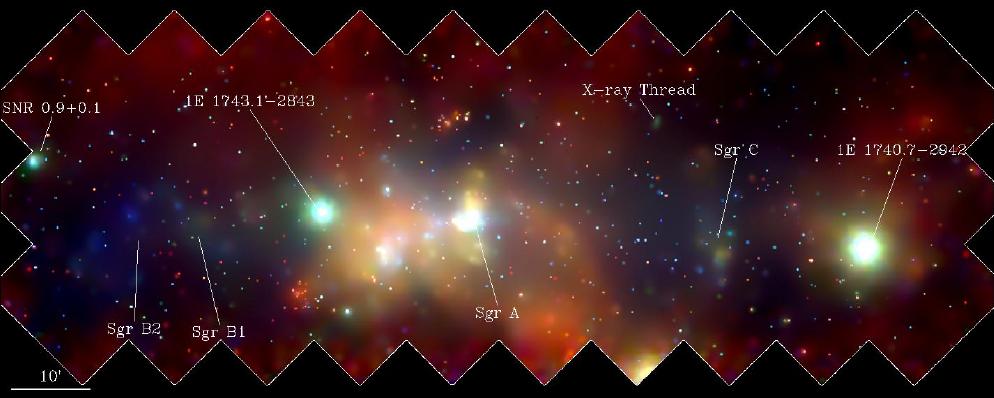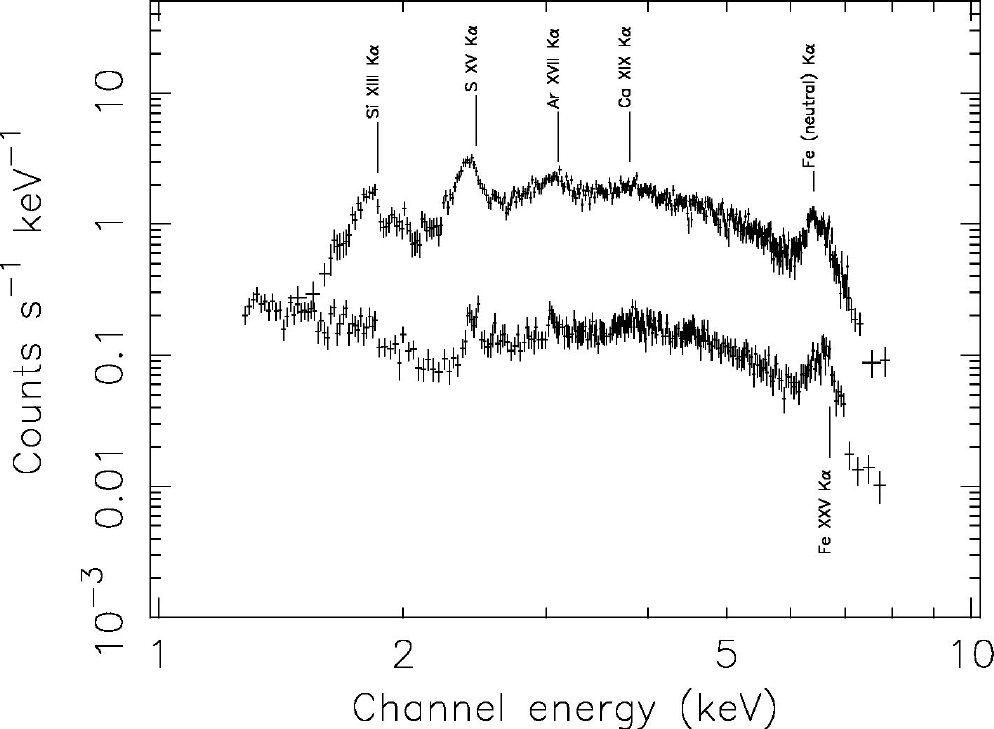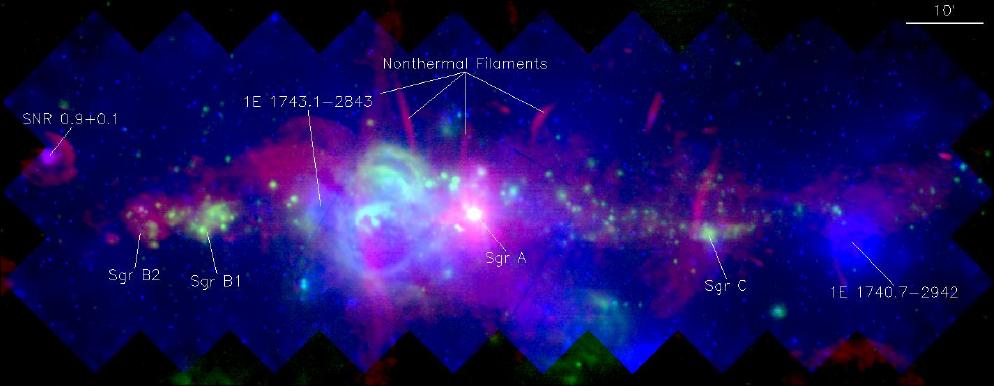
 GCNEWS
GCNEWS
A Newsletter for Galactic Center Research
This Volume was edited by Angela Cotera, Heino Falcke & Sera Markoff
email: gcnews@aoc.nrao.edu

 GCNEWS
GCNEWS


Cornelia C. Lang
(Department of Astronomy, University of Massachusetts, Amherst,
MA 01003,
USA)

I report on the results from the recent, high-resolution X-ray survey of the central 2 x 0.8 square degrees of the Galactic Center using the Chandra X-ray Observatory. We find that this region is rich in high-energy sources, both point-like and diffuse, and for the first time we can cleanly separate these components. Approximately 1000 point-like sources have been detected, of which less than 20 have been previously identified or have known counterparts. The extended, diffuse emission is the dominant component of X-ray emission in this region and appears to correspond to energetic massive star forming activities in the GC.
The unique morphology and distribution of radio and infrared features in the Galactic Center (GC) suggest that this region is a site of extremely energetic activities, however, the highest energy phenomena in the GC have not been well-characterized. X-ray emission is considered to be the best tracer of high energy astrophysical phenomena, yet differential interstellar absorption in the Galactic plane affects the surface brightness of the X-ray emission, especially for energies below 2 keV. Nearly all previous X-ray missions (EINSTEIN, GINGA, ROSAT, ASCA, BeppoSAX) have surveyed the GC region; however, the resolutions and energy bands have not been ideal for a complete study, in particular since the interstellar X-ray absorption prevents accurate determination of the intrinsic X-ray fluxes and morphologies of many sources. Observations of the GC using even the highest energy band of ROSAT PSPC (1.1-2 keV) suffered from absorption problems.
GINGA and ASCA opened up a new spectral window for observations of the GC, although with relatively low spatial resolution (Koyama et al. 1989, 1996). These observations illustrated for the first time that the GC was filled with a hot ( 108 K) tenuous gas showing prominent emission in spectral lines between 6-7 keV (e.g., 6.4-keV fluorescence and 6.7-keV Fe XXV K alpha ). However, this hard X-ray emission was not resolved due to the 3' spatial resolution. Several recent studies of the brightest point-like sources (using BeppoSaX and ROSAT PSPC) have revealed more than 50 bright X-ray sources this region, a number of which are well known X-ray binaries (Sidoli et al. 1999, 2001).
With the advent of the Chandra X-ray Observatory, operating in the energy window of 0.1-12 keV, it has now become possible to make X-ray images of the GC with spatial resolutions as high as 0.5-1'', for the first time comparable to the best near-infrared and radio observations of this region. The first Chandra observations at GC positions such as Sgr A* (Baganoff et al. 2001), Sgr B2 (Murakami et al. 2001) and the Radio Arc (Yusef-Zadeh et al. 2002) have revealed a wealth of point-like and diffuse emission sources. However, in order to comprehensively study the nature of the high-energy phenomena in this unique region of the Galaxy, we have imaged a large swath of the GC region using Chandra (Wang, Gotthelf & Lang 2002).

Our initial source-detection analysis reveals 1000 discrete X-ray sources above 3 sigma , of which only a small number (less than 20) have been previously identified. The strongest identified X-ray point-like emitters include the bright X-ray binaries 1E 1740.7-2942 and 1E 1743.1-2843, the nearby star HD316314, AX J1744.3-2940, and the Arches stellar cluster. We estimate that half of the detected point sources may be extragalactic background sources, based on a comparison with the density of sources in a relatively blank region of the Galactic plane (Ebisawa et al. 2001). Most of the sources are detected in the 2-10 keV energy band, with X-ray luminosities corresponding to 1032-1035 erg s-1 at the distance of the GC. The combined spectral signature of the point sources is shown in Figure 2 (lower spectrum) and provides some insight as to the nature of these sources. The presence of strong He-like Fe K alpha line emission at 6.7 keV in this spectrum indicates that these sources are likely to be accreting binary systems (white dwarf, neutron star, or black hole) (Barret et al. 2000). However, determining the true nature of these X-ray sources requires identification of their counterparts at other wavelengths and several follow up studies in the radio are currently underway. The fraction and distribution of these binary systems can provide important clues to the history of star formation activities in this region.
In addition to the X-ray point sources, we detect a significant amount of diffuse X-ray emission in the GC, concentrated in and around the region 10' offset from Sgr A complex (to the lower left in Figure 1). Figure 2 also shows the combined spectral signature from the diffuse emission (upper spectrum). The shape and line features of the two spectra are significantly different. The lack of strong 6.7 keV line emission in the diffuse spectrum and the presence of prominent ionized lines (e.g., Si XIII K alpha and S XV K alpha ) are characteristic of a plasma with temperature of 107 K. This temperature is consistent with an origin in young supernova renmants and massive star forming activities. Previous spectral analysis of the diffuse component with ASCA indicated that the diffuse emission had a temperature of 108 K, which is much harder to explain physically and to gravitationally confine to the GC region (Koyama et al. 1996).

The spectrum of the diffuse emission also shows a prominent 6.4-keV iron fluorescence emission, and much of this 6.4 keV line emission appears to be associated with the dense molecular clouds in Sgr A, B, and C as well as the Radio Arc region. However, the illuminating sources have not yet been identified and may arise from hard X-ray sources internal or external to the molecular clouds. Therefore, careful examination of the distribution of 6.4-keV emission, molecular gas and hard X-ray sources over large scales will help to resolve the source of this fluorescence emission.
Figure 3 shows a multi-wavelength view of the GC at radio (90 cm; LaRosa et al. 2000), mid-infrared (25 micron ; Price et al. 2001) and our X-ray (2-10 keV) data. The X-ray emission appears to be generally correlated with the massive star forming regions in the Radio Arc (the Arches and Quintuplet cluster regions) and the Sgr A and Sgr B2 complexes. This correlation suggests that the mechanical energy release from massive stars, in the form of supernova explosions and stellar winds, is at least partly responsible for the diffuse X-ray emission in the GC. The lack of correspondance between X-ray emission and non-thermal radio and mid-infrared sources indicates that non-thermal processes, such as inverse Compton scattering of the CMB or of the interstellar infrared radiation field do not contribute significantly to the observed diffuse X-ray emission.
One exception to this anti-correlation between non-thermal radio and X-ray features is the extended X-ray counterpart ( 1' or 2.5 pc in length) of the magnetic radio filament G359.54+0.18 (Yusef-Zadeh et al. 1997), which may provide new insight into the physical mechanism responsible for the acceleration of particles in these enigmatic filaments. On even larger scales (100 pc-1 kpc), correlations between diffuse X-ray emission and magnetic field structures in this region are crucial for understanding the history of energetic events in this active region. Our images suggest that the diffuse emission may extend beyond the region surveyed. It is thought that previous energetic activities in the GC may explain the large X-ray emission features detected in soft ROSAT X-ray images and may be related to the large, polarized plumes of radio continuum emission (Sofue 200). Vertical outflows of magnetized materials as is seen in nearby galaxies such as NGC4631 (Wang et al. 2001) have a profound impact on the mass, energy and metalicity balance in the galactic ISM.